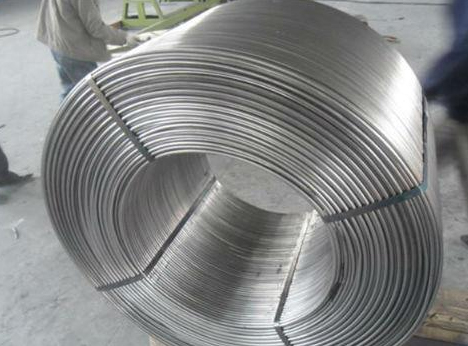
Calcium treatment is a crucial process in steel production that aims to enhance the purity and quality of steel. This article explores the significance of calcium treatment for achieving clean steel, focusing on its role in deoxidation, inclusion modification, desulfurization, and grain refinement. By understanding the benefits of calcium treatment, steel manufacturers can optimize their processes, increase productivity, and produce high-quality steel that meets the stringent requirements of diverse industries.
Deoxidation is a critical step in steelmaking to eliminate oxygen from the molten metal. Calcium treatment, typically performed by adding calcium alloys such as calcium silicon (CaSi) or calcium aluminum (CaAl), facilitates this process. Calcium has a strong affinity for oxygen, reacting with it to form calcium oxide (CaO) and other compounds. The deoxidation process helps remove oxygen from the steel, reducing the risk of oxide inclusions and improving steel purity. Calcium treatment enhances the cleanliness of steel, resulting in high-quality products with superior mechanical properties.

Non-metallic inclusions can significantly impact the mechanical properties of steel. Calcium treatment plays a crucial role in modifying and controlling the nature and composition of these inclusions. During the treatment, calcium reacts with impurities like sulfur, oxygen, and phosphorus, forming stable compounds. These compounds combine with the inclusions, leading to the formation of calcium-aluminate and calcium-silicate-based inclusions. The modified inclusions are more stable and less detrimental to the steel's mechanical properties, resulting in cleaner and higher-quality steel.
High sulfur content in steel can adversely affect its mechanical properties. Calcium treatment, typically carried out using calcium oxide (CaO) or calcium carbonate (CaCO3), is widely used for desulfurization. When calcium compounds are added to the steel melt, they react with sulfur, forming calcium sulfide (CaS). Calcium sulfide has a higher melting point than steel, allowing it to separate as slag, facilitating easy removal. Calcium treatment effectively reduces sulfur content, improving the steel's mechanical properties, such as ductility, toughness, and resistance to fracture.
Grain refinement is a critical aspect of steel production as it influences the steel's strength and durability. Calcium treatment, often utilizing calcium aluminates (CaAl2O4) or calcium silicates (CaSiO3), acts as a grain refiner during solidification. By introducing calcium-rich particles, the treatment promotes the formation of fine-grained microstructures, restricting grain growth. Refined grain structures enhance the steel's mechanical properties, including strength, ductility, and fatigue resistance. Calcium treatment contributes to the production of clean steel with improved performance and structural integrity.
The successful implementation of calcium treatment requires careful process optimization and control. Steel manufacturers must consider factors such as the calcium addition rate, reaction conditions, and refining techniques to achieve optimal results. Precise control of these parameters ensures effective deoxidation, inclusion modification, desulfurization, and grain refinement. Advanced process monitoring techniques, including thermodynamic calculations and in-line sensors, assist in real-time control and adjustment, enabling optimization of the calcium treatment process.
Continuous advancements in calcium treatment techniques and process control systems are expected to further enhance the quality and efficiency of steel production. Research efforts focus on refining calcium treatment methodologies, exploring alternative calcium alloys, and studying the effects of treatment on steel properties. Additionally, advancements in process modeling and simulation techniques allow for a more comprehensive understanding of the calcium treatment process, aiding in optimization and control. Future developments may involve the integration of calcium treatment with other refining methods to achieve even cleaner and higher-quality steel.
Calcium treatment is a vital process in steel production for achieving clean steel with enhanced purity and quality. Through deoxidation, inclusion modification, desulfurization, and grain refinement, calcium treatment optimizes the steel production process. Precise process optimization and control ensure efficient oxygen removal, inclusion control, and sulfur reduction, resulting in high-quality steel with superior mechanical properties. Continuous advancements in calcium treatment techniques and process control systems will further enhance the efficiency and effectiveness of steel production, enabling the production of clean steel that meets the stringent requirements of various industries.

Write a Message